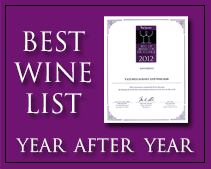A balanced and young cabernet sauvignon can often be virtually undrinkable. Philippines wine supplier Manila wine shop discusses wine by the grape variety Cabernet Sauvignon.
Date: December 12, 2010
If chardonnay is the darling of the white wine world, then cabernet sauvignon is the red wine equivalent. This grape variety makes most of the premium red wine the world over – if you have even only limited experience with red wine, chances are that cabernet sauvignon has passed your lips at least once.
The grape
Like most premium grape varieties, otherwise known as the noble vines, cabernet sauvignon belongs to a huge and diverse species, vitis vinifera. This species includes the grape varieties in just about all the wines you will find at your local bottle shop.
All grapes have clear juice; it is the colour of the skin that determines the final hue of the wine. Cabernet sauvignon happens to have some of the darkest skin of all these grape varieties – they are an impossibly deep blackish-purple that results in very deeply coloured wines. The grapes grow in compact, slender bunches and also possess relatively thick skins that cover small grapes. This last point is important – not only does the colour of the skins affect the final outcome, it is also the skin to juice ratio that provides cabernet sauvignon with its deep colour. Grape skins also contain masses of tannin. Obviously with so much skin being crushed to make cabernet sauvignon, the resultant wines can be highly tannic. This is often a prerequisite in creating wines designed for extended aging – a topic I will touch on later.
Part of this grape’s wide spread appeal is its ability to grow and produce good wines in a wide variety of regions and countries. Cabernet sauvignon vines are hardy and in the main, disease resistant. They consistently command high prices; so grape growers will be rewarded for growing them. Cabernet sauvignon also has a late vintage – long after other grape varieties have been picked, cabernet sauvignon is still on the vine catching some autumn sun. The effect of this is twofold; in mild to warm grape growing regions, this gives the grower ample opportunity to get the grapes to full ripeness, with a good sugar and acidity balance. However, in cooler regions, the early onset of frost can force the grower into picking the grapes before they are fully ripe. This means that very cool grown cabernet sauvignon can often taste thin and watery.
Where it all began
Like so much in the world of wine, the story of cabernet sauvignon begins in France. Nowhere in the world is cabernet sauvignon revered as highly as in the southwestern French region of Bordeaux. Unlike making wine in other countries, the French are very particular about which grape varieties are grown in what regions. In Bordeaux the king is cabernet sauvignon.
Bordeaux is also interesting for possessing a unique classification scheme ranking the winemaking houses or châteaux. It is known as The Bordeaux Classification of 1855 – and nothing has caused as much controversy in the history of wine. Around 60 or so châteaux are classified into 5 growths or “crus” There are 5 wines in the First Growth, or Premiers Crus, and they are among the most sought after, expensive and revered wines in the world, and they are all based heavily on cabernet sauvignon. These 5 lucky winemaking houses are Château Lafite-Rothschild, Château Latour, Château Haut-Brion, Château Margaux and the latecomer, Château Mouton-Rothschild, classified in 1973.
Making cabernet sauvignon
Making red wine is a very different business to making white – and this difference takes 2 main forms, skins and wood. If you crush red skinned grapes such as cabernet sauvignon, remove the skins and ferment the resultant clear juice, you will end up with white wine. The skins are everything to a red wine.
Once the grapes have been harvested and returned to the winery, they must be crushed and the stalks removed. The juice and skin slurry (known as must) is pumped into a fermenting vessel and yeast will commence the fermentation. This yeast will either be added by the winemaker – in the form of cultured yeast, or the wild yeasts present on the skin of the grapes are left to do the job. The wild yeast shows up quite nicely as a white bloom on the dark cabernet sauvignon skins.
As fermentation hits full swing, the yeast gives off a prodigious amount of carbon dioxide, which quickly lifts the grape skins to the surface of the fermenting wine in the form of a raft. This is not a good thing. Left to sit on the surface, the skins will provide a minimal amount of colour and tannin to the fermenting wine. The skins must be pushed back down into the wine and here the winemaker has several choices. If you want to go old school, you could take off your boots and jump on the raft of skins to submerge them ¹. Thankfully most winemakers now employ more sanitary methods to achieve this. Some use a large press that submerges the skins under the surface of the fermenting wine, while others will use a pump that shoots wine up over the skins, maximizing contact.
Once fermentation has completed, most light to medium-bodied wines are transferred to oak barrels for maturation, then bottled for sale. However, most cabernet sauvignon ends up as full-bodied wine and a further winemaking technique comes into play – maceration. This is a process of allowing fully fermented wine to sit with the skins for a period ranging from a few days up to several weeks, maximizing colour, flavour and tannin.
The fully fermented wine is now filtered and transferred to oak barrels for a maturation period of between 3 and 18 months. The wood influence adds depth and complexity to a young wine brimming with flavour and acidity.
Often at this stage cabernet sauvignon will be blended with other red wine varieties in an attempt to harmonize the best qualities of each grape. Cabernet sauvignon rarely has any trouble producing full flavoured wines, but it can taste raw and unapproachable in its youth. This is when softer wine varieties are blended so the wine is soft and approachable at a young age. The varieties most often blended with cabernet sauvignon are cabernet franc, merlot and malbec, although many Australian winemakers introduce the generous flavour of shiraz (syrah) to do the same job.
Cellaring cabernet sauvignon
Many winemakers produce, and many consumers buy wine with cellaring or aging in mind. Along with shiraz, cabernet sauvignon makes some of the most long-lived wines in the world. So what makes a wine age well? Two things actually – structure and balance.
Structure is fairly obvious. This refers to a wine possessing flavour characteristics – or an abundance of them – fruit, tannin and acid. See the little gap between the cork and the surface of the wine? ² This gap is known as ullage and is essential to aging wine.
The oxygen present in the ullage over time will react with the structure, or flavour characteristics of the wine – softening them and introducing new flavour elements as well. Now your particular bottle of cabernet sauvignon might have oodles of tannin, so it will age gracefully right? Wrong. This is where balance comes into play.
A balanced and young cabernet sauvignon can often be virtually undrinkable. It will have massive amounts of fruit flavour, as well as formidable acid and unapproachable tannins. Over time, oxygen will play its part and soften these elements – including the fruit, until they are approachable and delicious. If the structure was in balance as a young wine, it will most likely be in balance years later when you open the bottle – and you may just have a great bottle of wine on your hands.
Source: http://everything2.com/title/cabernet+sauvignon
Are these articles useful for enhancing your wine and dine experience in the Philippines. Do they also help you with travel, leisure, vacation, dining out, nightlife and other leisure activities plans in Manila and other major cities of Philippines? Yats Restaurant hopes to provide you with ample information so you can plan your trips to Pampanga Angeles City Clark Freeport Zone whether you are travelling from Manila or other Asian countries such as Hong Kong, Shanghai, Singapore, Malaysia or Korea.
Restaurant reservations in Manila Philippines, planning of menu, selection of wine for dinner and booking a private function and event in Angeles City Clark Freeport Zone can all be handled. Yats Restaurant and Wine Bar has been regarded by many to be the premier restaurant north of Manila Philippines. Its 3000-line award-winning restaurant wine list has kept many wine lovers happy dining in this restaurant in Angeles City Clark Philippines for over a decade.
Yats Restaurant and Wine Bar was built by Hong Kong-based Yats International in 2000 to provide a world-class cozy fine dining restaurant, business meeting facilities and venues for private dinners and functions in Pampanga Angeles City Clark Freeport Zone. Pampanga Angeles City Clark Philippines was selected for this restaurant because of safety, clean air, absence of traffic and proximity to Manila and Subic.
For comments, inquiries and reservations, email Restaurant@Yats-International.com or call these numbers:
(045) 599-5600 0922-870-5178 0917-520-4401
Http://www.YatsRestaurant.com
Getting to this fine dining restaurant of Angeles City Clark Freeport Zone Pampanga Philippines
How to get to this fine-dining restaurant in Clark Philippines? Once you get to Clark Freeport, go straight until you hit Mimosa. After you enter Mimosa, stay on the left on Mimosa Drive, go past the Holiday Inn and Yats Restaurant (green top, independent 1-storey structure) is on your left. Just past the Yats Restaurant is the London Pub.
The best restaurants in Pampanga can be found in Clark. Restaurants in Angeles City Pampanga offer meals at lower prices and cater to casual dining and budget tourists. Here food and wine lovers enjoy good food and fine wine in restaurants that are as good as the best restaurants in Manila. For wine lovers, a dinner at the famous Yats Restaurant in Clark Pampanga is a good treat. This restaurant offers a restaurant wine list that has no comparison even among the best restaurants in Manila. Many people want to train here in this famous restaurant to become a wine steward or sommelier in the Philippines.











